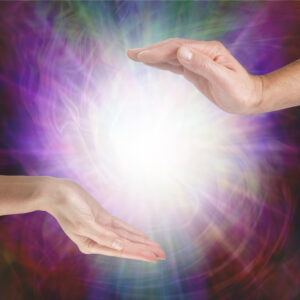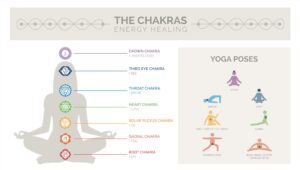
Energy Healing in Occupational Therapy
Energy healing is a gentle approach that can easily be integrated into occupational therapy practice to enhance an individual’s health and wellness. It may assist with recovery from illness and prevention of disease.
Occupational therapy practitioners may explore various non-pharmacological interventions for pain management, stress reduction, and enhancing overall well-being. These approaches align with the holistic nature of OT, aiming to address physical, mental, and spiritual aspects of health.
Energy healing is gaining acceptance and being used more in hospitals, clinics, and private practice due to its many health benefits.
These include, but are not limited to:
- Stress and anxiety reduction
- Pain reduction
- Improvement in mood and emotional well-being
- Reduction in symptoms of trauma and depression
- Improved sleep
- Improved gait speed and standing balance
- Support for healing and recovery
- Enhanced quality of life

What is Energy?
Energy also known as qi (chi), pronounced “chee”, is the vital life force in and around our bodies that gives and maintains life. Some may refer to as the spirit, soul, or universal life energy. Some say it is what is carried in the breath that keeps us in this world; also known as prana.
When it is flowing properly, we feel at our best. When it is constricted, limited, or blocked we may not feel that we’re operating as well. Energy is a virtual blueprint and foundation of our being; the physical, mental, emotional, and spiritual aspects. Our energy can be impacted if we’re feeling sad, happy, angry, or fearful and impact all areas of our life.
A simple way to understand energy is how we tend to talk about it in everyday language. For example, someone might say, “the room had a lot of energy,” “my energy is down,” or “she seemed really up.” We may also notice how much energy we have by how we feel inside our bodies and if we’re feeling “full of energy”, lethargic, “spent,” or just so-so. We may notice that being in a particular environment such as nature “restores our energy reserves.” Being with a particular person or group can leave us feeling drained or “lift our spirits or energy.”

Ancient Healing for Modern Times
Energy healing has been used in all cultures throughout history. In some cultures, it has its root in healing temples known as “laying on of hands” where the person receives divine life force channeled through the energy healer. In Traditional Chinese Medicine part of the energy system can be seen in an acupuncture chart. This is a map of the main energy channels or meridians that circulate energy to all the internal organs and all aspects of a person. The larger energy centers are known as chakras, which means “spinning wheel of light” in Sanskrit. There are seven main chakras along the spine, and one on each palm of the hands and the souls of the feet. The aura or energy field is energy around the body.
Energy Healing Styles
There are many styles of energy healing. All of them help return the energy back to balance. Some forms use touch and some use non-touch.
There are many activities and methods that can stimulate the flow of energy.
These include:
- Qigong
- Reiki
- Healing Touch
- Therapeutic Touch
- Other indigenous traditions, such as shamanism
Forms of energy healing that may stimulate, sedate, and balance the energy system through touch, pressure, or needles include:
- Acupressure
- Acupuncture
- Massage Therapy
- Reflexology
- Craniosacral Therapy
Movement that may balance the energy system, includes:
- Yoga
- Tai chi
- Dance
- Walking
- Being in Nature
- Other activities
Methods of energy healing that may transform limiting thoughts, beliefs, and emotions include:
- Meditation and Breath Work
- Mindfulness
- Guided Imagery
- Emotional Freedom Technique (EFT)
- Hakomi
- Body Talk
- Somato-Emotional Release

Energy Healing Session
The energy healer practitioner may use their hands and intuition to assess where the energy is flowing, blocked, or stagnant. They may move their hands above and around the recipient’s body to remove unwanted energy, bring in, and align the energy system. Touch use no touch or very light pressure on the body to return the flow of energy in and around the body of the recipient. Having an energy healing session can be very calming and insightful. All energy healers have a unique style.
Do you want to learn more about energy healing? Join the Energy Healing for Occupational Therapy class live on July 20, 2024 or get the recording.
References
Benson, Herb & Proctor, William (2010). Relaxation Revolution: Enhancing Your Personal Health Through the Science and Genetics of Mind Body Healing. New York, NY: Simon and Schuster, Inc.
Brennan, Barbara (1993). Light Emerging: The Journey of Personal Healing. New York, MY: Bantam Books.
Chang, P. S., Lu, Y., Nguyen, C. M., Suh, Y., Luciani, M., Ofner, S., & Powell, S. (2021). Effects of Qigong Exercise on Physical and Psychological Health among African Americans. Western journal of nursing research, 43(6), 551–562. https://doi.org/10.1177/0193945920959067
Krieger, Dolores (1979).The Therapeutic Touch: How to Use Your Hands to Help or Heal. New York, NY: Fireside.
Haas, Elson M. (1981). Staying Healthy with the Seasons. Berkeley, CA: Celestial Arts.
Healing Touch International. Retrieved from http://www.healingtouchinternational.org
McManus DE. Reiki Is Better Than Placebo and Has Broad Potential as a Complementary Health Therapy. J Evid Based Complementary Altern Med. 2017 Oct;22(4):1051-1057. doi: 10.1177/2156587217728644. Epub 2017 Sep 5. PMID: 28874060; PMCID: PMC5871310.
National QiGong Association. Retrieved from http://nqa.org
Reed Gach, Michael (1990). Acupressure’s Potent Points: A Guided to Self-Care for Common Ailments. New York, NY: Bantam Books.
Thie, John & Thie, Matthew (2004). Touch for Health: A Practical Guide to Natural Health with Acupressure Touch. Camarillo, CA: DeVorss Publications.





Leave a Reply